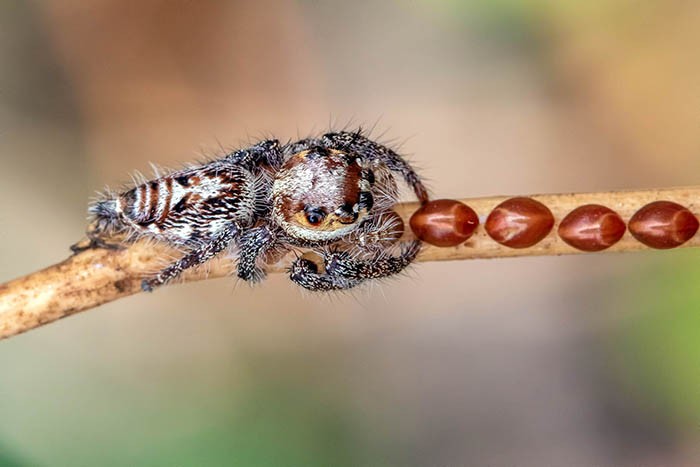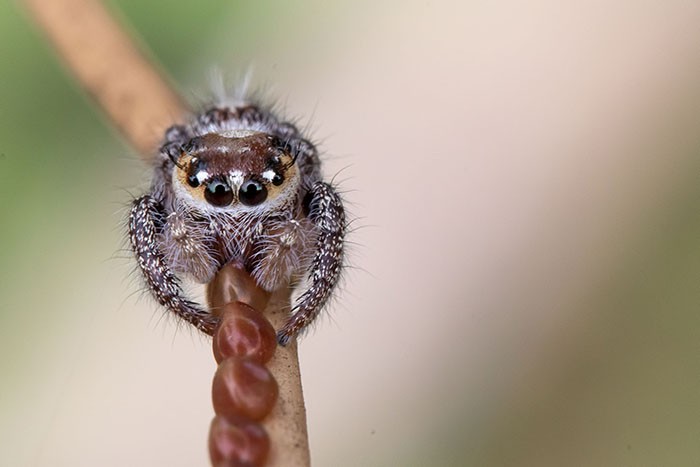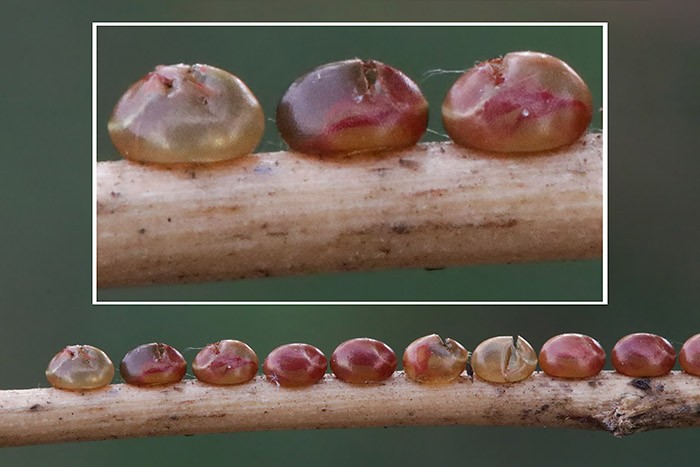►Spider’s newly discovered behaviour photographed for the first time.
►Social media helped in the discovery of the behaviour.
►The discovery is significant as it can help in biological methods of pest-control.
►Dr. Krishna Mohan, a Dakshina Kannadiga, is one of the experts involved in the study.
At a time of widespread complaints regarding misuse of social media by people, here is a heartening story of how social media served a useful purpose in advancing scientific knowledge about a unique species of spiders. Thanks to a sharp observation made by a Facebook user, one of the largest social media platforms in the country, an endemic South-Asian species of jumping spider, Hyllus semicupreus has been discovered to feed on insect eggs for the first time ever.
This behaviour is a new discovery for the species and has been reported by a team of researchers based in Mumbai, based on the inputs provided by a wildlife photographer from Andhra Pradesh. The discovery is significant as it can help in furthering biological means of pest control.

The discovery is published in the latest issue of 'Peckhamia', a globally renowned, peer-acclaimed international scientific journal dedicated to the study of jumping spiders. The study was collaborated with Dr. David E. Hill, a world authority on jumping spiders, and Dr. Richard J. Pearce, a leading British spider expert. It was led by principal author and lead researcher Javed Ahmed, along with co-researchers Rajashree Khalap and Dr. Krishna Mohan, who is a naturalist and surgeon based in Moodabidri. The discovery was reported by wildlife photographer AN Suresh Kumar, who first recorded this behavior and shared his observations with the team.
THE DISCOVERY
Hyllus semicupreus is a large, colourful bronze-colored jumping spider. It was previously recorded for the first time from Mumbai in 2015 and also been photographed across Maharashtra, especially in Raigad district. The spider can be easily identified from photographs and is known to feed on small insects and such.

Recently, and for the first time, wildlife photographer and amateur naturalist AN Suresh Kumar came across the spider feeding on leaf-footed bug eggs (familyCoreidae) on his farmland in Andhra Pradesh. Not knowing, he had clicked a new behavior and shared the photographs on the "Spiders of the Indian Subcontinent", a specialist Facebook group which is focusing on the documentation, identification and study of Indian spiders.
The photographs were spotted by arachnologist and researcher, Javed Ahmed. Realizing the importance of this chance discovery, Ahmed encouraged the photographer to contribute his findings to science to facilitate a better understanding of spiders, which are severely understudied in India compared to other wildlife species such as butterflies, birds and mammals.
'Oophagy' or preying on eggs is an interesting behavior, which, while reported in a number of jumping spiders, has never before been observed in Hyllus semicupreus, a relatively common jumping spider. This discovery is significant because leaf-footed bugs are severe agricultural pests and spiders such as Hyllus semicupreus can be acted as important pest-control agents.

Acknowledging the potential use of social media, Javed Ahmed observes: “In this digital age of lighting fast internet connections and powerful pocket computers (smart phones), which are carried by almost everyone, there's a lot of potential for social media platforms to act as a bridge between scientists and hobby photographers, to bring to light unique observations on the natural world never seen before. An important thing to remember though is, these observations, if not reported on an academic platform, such as a peer reviewed scientific journal, would be otherwise useless and lost forever.”
Photos: A. N. Suresh Kumar
Let the Truth be known. If you read VB and like VB, please be a VB Supporter and Help us deliver the Truth to one and all.
Kolkata (PTI): A local Trinamool Congress (TMC) leader was murdered by unidentified assailants in West Bengal's Birbhum district, police said on Saturday.
Rajbehari Sardar (65), TMC's booth chief in Patisara gram panchayat, was stabbed and severely beaten up by around five-six people at a function in Nanoor area around 10 pm on Friday, a police officer said.
Sardar was taken to Mangalkot Hospital in neighbouring Purba Bardhaman district where he was declared dead by doctors, he said.
The deceased's son alleged that Sardar was killed by members of a rival faction of the party.
The local TMC leadership said Sardar was a committed party worker and was popular in the area, but claimed that there was no report of the involvement of anyone from the party in the murder.
"We demand a thorough and prompt investigation into the incident," a local TMC leader said.





